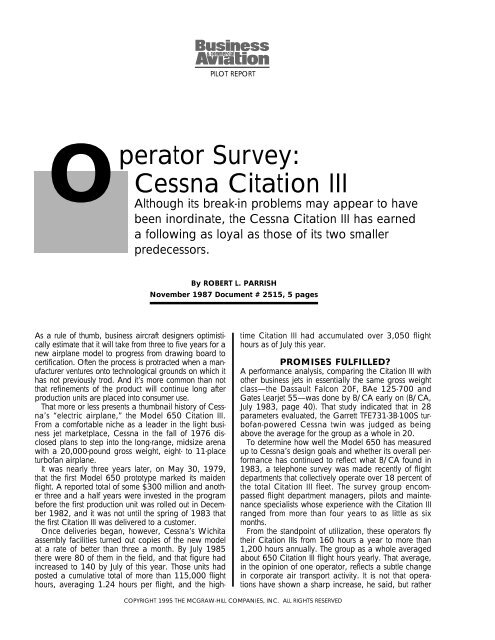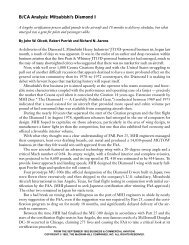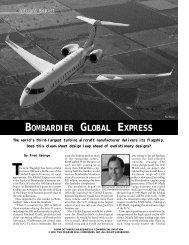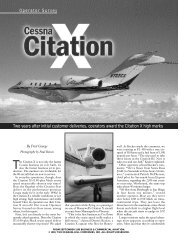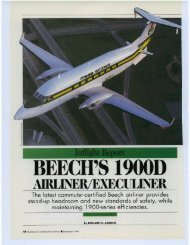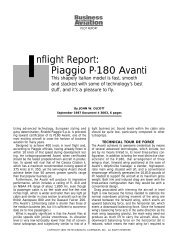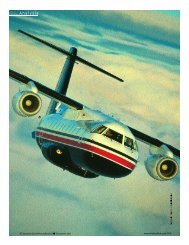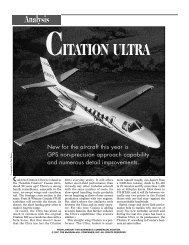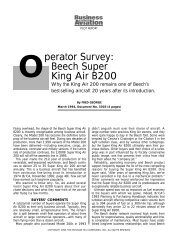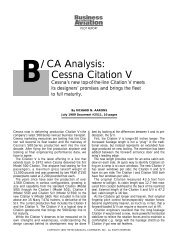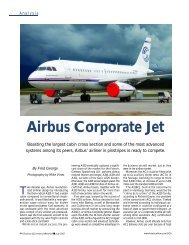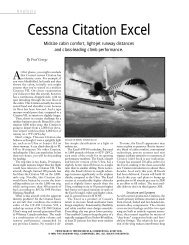Operator Survey: Cessna Citation III
Operator Survey: Cessna Citation III
Operator Survey: Cessna Citation III
Create successful ePaper yourself
Turn your PDF publications into a flip-book with our unique Google optimized e-Paper software.
PILOT REPORT<br />
O<br />
perator <strong>Survey</strong>:<br />
<strong>Cessna</strong> <strong>Citation</strong> <strong>III</strong><br />
Although its break-in problems may appear to have<br />
been inordinate, the <strong>Cessna</strong> <strong>Citation</strong> <strong>III</strong> has earned<br />
a following as loyal as those of its two smaller<br />
predecessors.<br />
By ROBERT L. PARRISH<br />
November 1987 Document # 2515, 5 pages<br />
As a rule of thumb, business aircraft designers optimistically<br />
estimate that it will take from three to five years for a<br />
new airplane model to progress from drawing board to<br />
certification. Often the process is protracted when a manufacturer<br />
ventures onto technological grounds on which it<br />
has not previously trod. And it’s more common than not<br />
that refinements of the product will continue long after<br />
production units are placed into consumer use.<br />
That more or less presents a thumbnail history of <strong>Cessna</strong>’s<br />
“electric airplane,” the Model 650 <strong>Citation</strong> <strong>III</strong>.<br />
From a comfortable niche as a leader in the light business<br />
jet marketplace, <strong>Cessna</strong> in the fall of 1976 disclosed<br />
plans to step into the long-range, midsize arena<br />
with a 20,000-pound gross weight, eight- to 11-place<br />
turbofan airplane.<br />
It was nearly three years later, on May 30, 1979,<br />
that the first Model 650 prototype marked its maiden<br />
flight. A reported total of some $300 million and another<br />
three and a half years were invested in the program<br />
before the first production unit was rolled out in December<br />
1982, and it was not until the spring of 1983 that<br />
the first <strong>Citation</strong> <strong>III</strong> was delivered to a customer.<br />
Once deliveries began, however, <strong>Cessna</strong>’s Wichita<br />
assembly facilities turned out copies of the new model<br />
at a rate of better than three a month. By July 1985<br />
there were 80 of them in the field, and that figure had<br />
increased to 140 by July of this year. Those units had<br />
posted a cumulative total of more than 115,000 flight<br />
hours, averaging 1.24 hours per flight, and the hightime<br />
<strong>Citation</strong> <strong>III</strong> had accumulated over 3,050 flight<br />
hours as of July this year.<br />
PROMISES FULFILLED?<br />
A performance analysis, comparing the <strong>Citation</strong> <strong>III</strong> with<br />
other business jets in essentially the same gross weight<br />
class—the Dassault Falcon 20F, BAe 125-700 and<br />
Gates Learjet 55—was done by B/CA early on (B/CA,<br />
July 1983, page 40). That study indicated that in 28<br />
parameters evaluated, the Garrett TFE731-3B-100S turbofan-powered<br />
<strong>Cessna</strong> twin was judged as being<br />
above the average for the group as a whole in 20.<br />
To determine how well the Model 650 has measured<br />
up to <strong>Cessna</strong>’s design goals and whether its overall performance<br />
has continued to reflect what B/CA found in<br />
1983, a telephone survey was made recently of flight<br />
departments that collectively operate over 18 percent of<br />
the total <strong>Citation</strong> <strong>III</strong> fleet. The survey group encompassed<br />
flight department managers, pilots and maintenance<br />
specialists whose experience with the <strong>Citation</strong> <strong>III</strong><br />
ranged from more than four years to as little as six<br />
months.<br />
From the standpoint of utilization, these operators fly<br />
their <strong>Citation</strong> <strong>III</strong>s from 160 hours a year to more than<br />
1,200 hours annually. The group as a whole averaged<br />
about 650 <strong>Citation</strong> <strong>III</strong> flight hours yearly. That average,<br />
in the opinion of one operator, reflects a subtle change<br />
in corporate air transport activity. It is not that operations<br />
have shown a sharp increase, he said, but rather<br />
COPYRIGHT 1995 THE MCGRAW-HILL COMPANIES, INC. ALL RIGHTS RESERVED
P ilot<br />
Report<br />
that flight departments have fewer aircraft and now<br />
appear to be operating them more efficiently.<br />
Most members of the survey group claimed that for<br />
their given mission requirements they believe the <strong>Citation</strong><br />
<strong>III</strong> is the most suitable business jet on the market for<br />
the price—about $6.2 million B/CA equipped. And if<br />
they were called upon today to select a replacement or<br />
additional aircraft for the same type of air transportation<br />
needs, it would be a current model of the same aircraft.<br />
But for some, that would not have been the case<br />
as recently as six months ago.<br />
The reason given was that the <strong>Citation</strong> <strong>III</strong> is an aircraft<br />
on which full development has been (or is being) completed<br />
on the basis of experience gained through its use<br />
in the field. While there have been only two ADs<br />
against it—pertaining to potential electrical fires, which<br />
are not unique to the <strong>Cessna</strong> 650—there have been “a<br />
pot full of service bulletins,” several operators complained.<br />
<strong>Cessna</strong> marketing personnel acknowledged<br />
that well over 100 SBs and service letters have been<br />
disseminated during the <strong>Citation</strong> <strong>III</strong>’s brief history, but<br />
those officials stressed that few of them were mandated<br />
corrective actions and that the vast majority can be<br />
attributed to what the manufacturer regards as an ongoing<br />
product-improvement effort.<br />
Basic design objectives for the <strong>Citation</strong> <strong>III</strong> reportedly<br />
were to provide an executive aircraft with at least 50<br />
percent more internal living space, 20 percent more<br />
speed, some 40 percent greater range and nearly 40<br />
percent more useful load capability than those afforded<br />
by the earlier <strong>Citation</strong> II but with about the same<br />
level of fuel economy and better ability to conform to<br />
the most exacting FAR Part 36 noise standards. Mechanisms<br />
employed to accomplish the objectives included<br />
adaptation of a supercritical wing, greater use of<br />
lightweight composite materials and extensive electrical/computer<br />
applications to subsystems monitoring<br />
and control functions.<br />
The operators surveyed by B/CA agreed that targeted<br />
objectives have generally been met. But advanced<br />
technologies employed in the process were blamed for<br />
initially extracting exorbitant tolls in dispatch reliability.<br />
One flight department manager claimed, in fact, that<br />
during the first year his company flew the <strong>Citation</strong> <strong>III</strong>,<br />
the airplane spent 244 days in the shop undergoing<br />
systems modifications, service and repairs. Others complained<br />
not about any single major problem area but of<br />
continuing minor malfunctions and glitches that disrupted<br />
flight schedules and impeded effective utilization of<br />
the aircraft.<br />
A conglomerate profile of operations surveyed<br />
showed that the group as a whole varies somewhat<br />
from fleet-wide characteristics compiled by <strong>Cessna</strong>.<br />
The survey sample, for instance, reported higher average<br />
utilization of their equipment than that computed<br />
by the OEM.<br />
Average load factors—placed at better than 4.5—<br />
also were higher, as were en route cruise speeds,<br />
which were flight planned at an average of 450 knots.<br />
However, fuel flows—reported at overall average rates<br />
of between 1,400 and 1,450 pounds per hour—were<br />
lower than those contained in <strong>Cessna</strong> manuals.<br />
SYSTEMS SNAFUS<br />
By and large, the most aggravating and numerous of<br />
problems revealed by those surveyed were related to<br />
the <strong>Citation</strong> <strong>III</strong> flap, environmental conditioning and horizontal<br />
tail anti-icing systems, although the electrical<br />
and anti-ice/deice systems in general drew critical comments.<br />
At the same time, <strong>Cessna</strong>’s product-support<br />
efforts, in many cases extending beyond the 1,000-<br />
hour aircraft warranty period, merited almost unanimous<br />
praise.<br />
And a strong correlation can be made between the<br />
age of individual aircraft (as reflected by serial number)<br />
and the frequency and perceived severity of problems<br />
experienced. <strong>Cessna</strong> explained this by pointing out that<br />
as defects and potential shortcomings have been discerned<br />
at company-owned or company-authorized service<br />
centers, every effort has been made to incorporate<br />
fixes into the production process.<br />
All of the aircraft included in the users’ survey were<br />
configured in seven-passenger plus lavatory seating<br />
arrangement; about half were equipped with electronic<br />
flight instrument systems (EFIS), the majority Sperrymade<br />
since that is the primary optional installation, but<br />
with Bendix and Collins also represented; and some 60<br />
percent had a factory-installed APU. All aircraft prior to<br />
Serial Number 100 were equipped with Sundstrand<br />
air-cycle machines; one to provide cockpit environmental<br />
conditioning and a second identical machine to cool<br />
and heat the passenger cabin. From Serial Number<br />
100 on, those units have been replaced with larger,<br />
higher-capacity Hamilton Standard air-cycle machines.<br />
Several survey respondents indicated that the primary<br />
incentives to select the <strong>Citation</strong> <strong>III</strong> over competitive aircraft<br />
were acquisition cost, along with cabin space,<br />
promised operating economy, speed and range.<br />
Among nine executive jets listed in B/CA’s 1987 Planning<br />
and Purchasing Handbook that could be considered<br />
as market competitors, however, the <strong>Cessna</strong><br />
Model 650 was estimated as the third most expensive,<br />
when comparably equipped.<br />
In terms of certified ceiling, true airspeed and fuel<br />
flow, the <strong>Citation</strong> <strong>III</strong> equaled or exceeded the capabilities<br />
of most of that competition, on paper at least. From<br />
the real-world aspect, however, several of the operators<br />
expressed disappointment with the <strong>Citation</strong> <strong>III</strong>’s range<br />
COPYRIGHT 1995 THE MCGRAW-HILL COMPANIES, INC. ALL RIGHTS RESERVED
P ilot<br />
Report<br />
and second-segment climb abilities.<br />
“The aircraft manual claims the <strong>Citation</strong> <strong>III</strong> has a<br />
range of 2,540 nm with NBAA IFR reserve fuel,” noted<br />
one operator, “but I’d be uncomfortable in attempting<br />
any nonstop flight of more than 2,100 nm if I had much<br />
of a payload aboard.” He and several others suggested<br />
that from a practical standpoint an 1,800 nm maximum<br />
IFR range would be more reasonable for flight<br />
planning purposes. (B/ CA computed an NBAA IFR<br />
range of 2,094 nm with four passengers in our April<br />
1987 Handbook).<br />
Some of the more experienced <strong>Citation</strong> <strong>III</strong> operators<br />
also were critical of what they regard as the hot-day,<br />
high-altitude limitations of the aircraft. Said one: “A 95<br />
degrees F day in Denver is going to cost as much as<br />
4,000 pounds in useful load, and our company officers<br />
can get pretty upset when an airplane they bought for<br />
its speed and range cannot make either the East Coast<br />
or West Coast without having to land to refuel en<br />
route.”<br />
THE ATTRIBUTES<br />
Generally, though, crew satisfaction with the aircraft’s<br />
performance and handling characteristics far outweighed<br />
any dislikes expressed. Among features mentioned<br />
as best-liked were the <strong>Citation</strong> <strong>III</strong>’s:<br />
Speed and altitude capabilities— (a cruise of 0.81<br />
to 0.83 Mach and MMO of 0.851, with a 51,000-foot<br />
service ceiling and optimum flight altitudes of FL 370 to<br />
FL 450 achieved without step-climbing.<br />
Trouble-free, dependable powerplants—Surprisingly,<br />
not one operator interviewed by B/CA reported any<br />
significant engine problems.<br />
Operational flexibility—Thirty-minute missions were<br />
reportedly performed almost as economically as those<br />
of 1,000 to 1,500 nm, where the superior speed and<br />
stability of the aircraft were said to cause it to really<br />
shine.<br />
Operational simplicity—<strong>Operator</strong>s noted the ease<br />
with which the <strong>Citation</strong> <strong>III</strong> can be hand-flown with the<br />
autopilot and yaw damper disengaged, and one pilot<br />
remarked, “Start-up and shutdown procedures are so<br />
uncomplicated that I feel like I must be forgetting something.”<br />
Specific fuel consumption—Over 1,000-nm stages<br />
the <strong>Citation</strong> <strong>III</strong> will use about the same amount of fuel as<br />
the smaller <strong>Citation</strong> II because it will complete the trip in<br />
less time, several operators said.<br />
Speed margins and landing capabilities—<strong>Operator</strong>s<br />
like the broad latitude between the minimum speed<br />
and stall speed, and the invariably good landings that<br />
result from the trailing-link gear.<br />
Interior size and noise levels— Stand-up cabin<br />
room, spaciousness of the cockpit, the airplane’s quietness<br />
inside and out, and the overall level of interior<br />
decor and comfort are appreciated by <strong>Citation</strong> <strong>III</strong> operators.<br />
The APU, which in later units is certified for operation<br />
in flight.<br />
Separate environmental control units for the cockpit<br />
and cabin.<br />
Ample baggage space and weight capacity.<br />
Worth noting is the fact that the majority of operators<br />
contacted fell into one of two categories. Either their<br />
companies were traditional users of <strong>Cessna</strong> products<br />
and they had stepped up from smaller <strong>Citation</strong> models,<br />
or they had changed over from Learjet 20 or 30 series<br />
aircraft. In either case, both flight crews and passengers<br />
were pleased with the added space and comfort<br />
afforded by the <strong>Citation</strong> <strong>III</strong>. A flight department manager<br />
whose firm replaced two Gulfstream Is with <strong>Citation</strong><br />
<strong>III</strong>s, another who replaced a Sabreliner 60 and one<br />
who traded a Falcon 20 for the <strong>Citation</strong> <strong>III</strong> all reported<br />
that their passengers were less impressed by the cabin<br />
size than by the new aircraft’s low noise level and<br />
greater speed.<br />
THE DOWNSIDE<br />
Features of the <strong>Citation</strong> <strong>III</strong> cited as least liked included:<br />
Its inability to deliver the claimed transcontinental<br />
nonstop range— When pressed, most operators admitted<br />
the range is adequate for their typical stage lengths,<br />
but an added 500 nm of capability would greatly<br />
enhance the <strong>Citation</strong> <strong>III</strong>’s value, one contended.<br />
System and component problems—Difficulties with<br />
the heating and cooling system, hydraulic, pneumatic<br />
and fuel valve, connectors, anti-ice/ deice components<br />
and electrical wiring bundles, which allegedly are<br />
installed in a manner that impedes troubleshooting and<br />
service functions.<br />
Quality control and spare parts inventories at <strong>Cessna</strong>’s<br />
<strong>Citation</strong> service centers—Several operators<br />
charged that the centers lack uniformity in both procedures<br />
and quality. “I’ve dealt with almost every <strong>Citation</strong><br />
center in North America,” said one, “and while I’ve<br />
found the personnel at most of them to be obliging,<br />
their work has run the gamut from excellent to unsatisfactory.<br />
The only consistency I’ve seen is a common<br />
lack of needed spares in inventory.”<br />
Failure or malfunction of MEL dispatch items like<br />
flaps, certain instruments, stabilizer anti-ice blankets<br />
and valves—Noted the operator of an early production<br />
unit: “<strong>Cessna</strong> cannot have made any money on our aircraft<br />
because of the time and parts provided under warranty.<br />
At the same time, there has been a cost to us in<br />
having to dispatch another airplane to transport stranded<br />
passengers.”<br />
Unsatisfactory maintenance access to many critical<br />
COPYRIGHT 1995 THE MCGRAW-HILL COMPANIES, INC. ALL RIGHTS RESERVED
P ilot<br />
Report<br />
and short-lived components—A flight department manager<br />
reported that anti-ice pilot/slave valves on his aircraft<br />
were failing at about two-week intervals and to<br />
replace them required removal of the engine thrust<br />
reversers, a two-day job in itself.<br />
Difficulty in troubleshooting electrical system-related<br />
problems—Several of those operators interviewed<br />
attributed miscellaneous component difficulties to the<br />
electrical system, and one recalled taking his aircraft to<br />
the Wichita <strong>Citation</strong> service center three times before<br />
the cause of an instrument malfunction finally was isolated<br />
as a chafed wire bundle. “When they put the <strong>Citation</strong><br />
<strong>III</strong> together, it seems like they wanted it to stay just<br />
the way they built it,” said the maintenance chief of<br />
another operation.<br />
Remote location of the circuitbreaker box where<br />
the flight crew cannot get at it in flight—A pilot noted<br />
that the aircraft operators manual requires that the airplane<br />
be landed immediately if the circuit-breaker warning<br />
light illuminates. On one occasion, he said, a<br />
passenger cabin stereo set anomaly led to an aborted<br />
takeoff run, and on another a malfunction in the lavatory<br />
flushing system resulted in an unscheduled landing.<br />
Bleed-air performance and noise—<strong>Operator</strong>s cited<br />
the inadequate windshield defogging ability of the<br />
bleed-air system and noise created by the windshield<br />
fan, which can interfere with radio communication during<br />
critical phases of flight.<br />
A cruise climb rate that contrasts with the aircraft’s<br />
otherwise outstanding high-performance characteristics—<br />
In a head-to-head comparison between a Learjet<br />
35 and the <strong>Citation</strong> <strong>III</strong> on trips of an hour or less, the<br />
modest climb rate of the <strong>Citation</strong> <strong>III</strong> offsets its superior<br />
en route speed, claimed a manager whose department<br />
operates both models.<br />
Repeated APU failures—Several operators have<br />
experienced numerous APU breakdowns and feel that<br />
there is a need for correction of a suspected link<br />
between the APU and the air-cycle machines that precipitates<br />
failure of the latter.<br />
Despite the length of this squawk list, a surprising<br />
number of operators insisted that they had experienced<br />
relatively fewer serious problems with the <strong>Citation</strong> <strong>III</strong><br />
than they had anticipated, or than they had experienced<br />
with other aircraft models. The most potentially<br />
hazardous problem disclosed by the survey was one in<br />
which fuel unporting from the wing tanks to the forward<br />
fuselage tank could cause a nose-heavy condition on<br />
landing approach, under certain conditions.<br />
And virtually all of those contributing to the survey<br />
agreed on three points:<br />
(1) Overall, the <strong>Citation</strong> <strong>III</strong> meets or exceeds primary<br />
performance specifications contained in the AOM;<br />
(2) <strong>Cessna</strong> has been conscientious in its product-support<br />
efforts;<br />
(3) With time, the <strong>Citation</strong> <strong>III</strong> has become increasingly<br />
more reliable, even though some problems still may<br />
exist.<br />
Among those who have tracked the dispatch reliability<br />
rates most carefully, it was reported that mechanical<br />
situations have resulted more in flight schedule delays<br />
than in cancellations, and trip completion rates were<br />
computed in the 97 to 99.9 percent range.<br />
CESSNA’S SOLUTIONS<br />
What <strong>Cessna</strong> has done in response to specific complaints<br />
was relayed from <strong>Citation</strong> <strong>III</strong> program engineers<br />
by David W. Carter, director of marketing communications.<br />
A major effort and the subject of many of the SBs<br />
that have been issued, he disclosed, has focused on<br />
refinement of subsystems arrangement, maintenance<br />
accessibility and inspection schedules.<br />
One significant advance was a landing gear and<br />
brake modification program that permitted increased<br />
ramp, takeoff and landing weights. Another was<br />
improvement of the APU installation that reportedly has<br />
resulted in fewer problems both with that unit and the<br />
air-cycle machines. Another was re-engineering of the<br />
wing flap control and asymmetric brake systems that<br />
has minimized reports of flap freeze situations, <strong>Cessna</strong><br />
claimed.<br />
Still another was a change in air-cycle machine vendors<br />
and refinements to the earlier air-cycle units that<br />
are reported to have radically reduced unscheduled<br />
removals. In August, <strong>Cessna</strong> acknowledged that discussions<br />
were being held with prospective new suppliers of<br />
subsystem control valves. In addition, the vendor for the<br />
<strong>Citation</strong> <strong>III</strong> anti-ice/deice systems reportedly has made<br />
several significant improvements in its products.<br />
Plans also were in the mill in August to fine-tune the<br />
entire electrical system by redesigning some junction<br />
boxes and eliminating others, Carter revealed, and a<br />
“bagged” noise insulation modification has been made<br />
available for <strong>Citation</strong> <strong>III</strong> operators whose aircraft may<br />
need further silencing treatment.<br />
No changes are currently planned, however, for the<br />
aircraft’s unique hydraulic swage fittings or for conversion<br />
from the non-corrosive hydraulic fluid now used,<br />
according to Carter. Neither is there any project in process<br />
to change the windscreen bleed-air defogging<br />
mechanism.<br />
Carter indicated that <strong>Cessna</strong> engineers expressed surprise<br />
when informed that the bleed-air system and<br />
defogging fan in combination caused noise interference<br />
with radio communication. This complaint was mentioned<br />
by several of the operators interviewed, however,<br />
so it must be assumed that it has some validity.<br />
Most of the post-certification improvements devised<br />
COPYRIGHT 1995 THE MCGRAW-HILL COMPANIES ALL RIGHTS RESERVED
P ilot<br />
Report<br />
for the <strong>Citation</strong> <strong>III</strong>—with the notable exception of the<br />
air-cycle machines— can be retrofitted on early units,<br />
Carter said. In his opinion, that should enable those aircraft<br />
to be upgraded to a state of product maturity<br />
equal to that of current production units.<br />
<strong>Cessna</strong> has been aware of inadequacies in its service<br />
center structure and has been working hard to overcome<br />
them, Carter added. Efforts are underway now to<br />
both beef up parts inventories at the centers and to train<br />
their personnel to more effectively incorporate product<br />
improvements and modifications into <strong>Citation</strong> <strong>III</strong> inspection<br />
programs, he claimed.<br />
Several of B/CA’s survey respondents cautioned,<br />
however, that flight departments considering acquisition<br />
of a used Model 650 would be well-advised to investigate<br />
thoroughly the structural impact that some of the<br />
later modifications might have on earlier airframes and<br />
systems (those aircraft preceding serial number 50 or<br />
75).<br />
<strong>Cessna</strong> indicated that the <strong>Citation</strong> <strong>III</strong> had “reached<br />
full maturity” at or near completion of the 100th production<br />
unit and that it expects complaints to dwindle. But<br />
<strong>Cessna</strong>’s promise was that each will be given the same<br />
high level of product support as the company has<br />
attempted to provide in the past.<br />
Despite its rash of introductory hiccups, the <strong>Cessna</strong><br />
<strong>Citation</strong> <strong>III</strong> obviously has filled a market need. And as<br />
long as speed and ease of handling remain important<br />
to prospective customers, the <strong>Citation</strong> <strong>III</strong> should continue<br />
to enlarge upon its past success. B/CA<br />
COPYRIGHT 1995 THE MCGRAW-HILL COMPANIES ALL RIGHTS RESERVED


